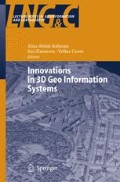Abstract
Photogrammetric mapping procedures have gone through major developments as a result of the significant improvements in its underlying technologies. For example, the continuous development of digital imaging systems has lead to the steady adoption of digital frame and line cameras in mapping activities. Moreover, the availability of GPS/INS systems facilitated the direct geo-referencing of the acquired imagery. Still, photogrammetric datasets taken without the aid of positioning and navigation systems need control information for the purpose of surface reconstruction. So far, distinct point features have been the primary source of control for photogrammetric triangulation although other higher-order features are available and can be used. In addition to photogrammetric data, LIDAR systems supply dense geometric surface information in the form of three dimensional coordinates of laser footprints with respect to a global reference system. Considering the accuracy improvement of LIDAR systems in the recent years, which is propelled by the continuous advancement in GPS/INS technology, LIDAR data is considered a viable supply of control for photogrammetric geo-referencing. In this paper, alternative methodologies will be devised for the purpose of integrating LIDAR data into the photogrammetric triangulation. Such methodologies will deal with two main issues: utilized primitives and the respective mathematical models. More specifically, two methodologies will be introduced that utilize straight-line and areal features derived from both datasets as the primitives. The first methodology directly incorporates LIDAR lines as control information in the photogrammetric triangulation, while in the second methodology, LIDAR patches are used to geo-reference the photogrammetric model. The feasibility of the devised methods will be investigated through experimental results with real data
Access this chapter
Tax calculation will be finalised at checkout
Purchases are for personal use only
Preview
Unable to display preview. Download preview PDF.
References
Baltsavias, E., 1999. A comparison between photogrammetry and laser scanning, ISPRS Journal of Photogrammetry & Remote Sensing, 54(l):83–94.
Chen, L., Teo, T., Shao, Y., Lai, Y., Rau, J., 2004. Fusion of LIDAR data and optical imagery for building modeling, International Archives of Photogrammetry and Remote Sensing, 35(B4):732–737.
Cramer, M., Stallmann, D., Haala, N., 2000. Direct georeferencing using GPS/Inertial exterior orientations for photogrammetric applications, International Archives of Photogrammetry and Remote Sensing, 33(B3): 198–205.
Fraser, C., Hanley, H., Yamakawa, T., 2002. High-Precision Geopositioning from IKONOS Satellite Imagery, Proceeding of ACSM-ASPRS 2002, Washington, DC, USA, unpaginated CD-ROM.
Fraser, C., Hanley, H., 2003. Bias compensation in Rational Functions for IKONOS Satellite Imagery, Photogrammetric Engineering & Remote Sensing, 69(1): pp. 53–57.
Habib, A., Schenk, T., 1999. A new approach for matching surfaces from laser scanners and optical sensors, International Archives of Photogrammetry and Remote Sensing, 32(3W14):55–61.
Habib, A., Lee, Y., Morgan, M., 2001. Bundle Adjustment with Self-Calibration of Line Cameras using Straight Lines, Joint Workshop of ISPRS WG I/2,I/5 and IV/7: High Resolution Mapping from Space 2001, 19–21 September 2001, University of Hanover, Hanover, Germany, unpaginated CD-ROM.
Habib, A., Kim, E., Morgan, M., Couloigner, I., 2004. DEM Generation from High Resolution Satellite Imagery Using Parallel Projection Model, Proceeding of the XXth ISPRS Congress, Commission 1, TS: HRS DEM Generation from SPOT-5 HRS Data, 12–23 July 2004, Istanbul, Turkey, pp. 393–398.
Habib, A., Morgan, M., Lee, Y., 2002. Bundle adjustment with self-calibration using straight lines, Photogrammetric Record, 17(100): 635–650.
Hanley, H., Yamakawa, T., Fraser, C., 2002. Sensor Orientation for High Resolution Satellite Imagery, Pecora 15/Land Satellite Information IV/ISPRS Commission I/FIEOS, 10–15 November 2002, Denver, USA, unpaginated CD-ROM.
Lee, C., Thesis, H., Bethel, J., Mikhail, E., 2000. Rigorous Mathematical Modeling of Airborne Pushbroom Imaging Systems, Photogrammetric Engineering & Remote Sensing, 66(4): pp. 385–392.
Lee, Y., Habib, A., 2002. Pose Estimation of Line Cameras Using Linear Features. Proceedings of ISPRS Commission III Symposium “Photograrnmetric Computer Vision”, Graz, Austria, September 9–13, 2002.
Poli, D., 2004. Orientation of Satellite and Airborne Imagery from Multi-line Pushbroom Sensors with a Rigorous Sensor Model, International Archives of Photogrammetry and Remote Sensing, Istanbul, Turkey, 34(B1): pp. 130–135.
Tao, V., Hu, Y., Jiang, W., 2004. Photogrammetric Exploitation of IKONOS Imagery for Mapping Applications, International Journal of Remote Sensing, 25(14): pp. 2833–2853.
Tao, V., Hu, Y., 2001. A Comprehensive Study of Rational Function Model for Photogrammetric Processing, Photogrammetric Engineering & Remote Sensing, 67(12): pp. 1347–1357.
Toutin, T., 2004. DSM Generation and Evaluation from QuickBird Stereo Images with 3D Physical Modeling and Elevation Accuracy Evaluation, International Journal of Remote Sensing, 25(22): pp. 5181–5192.
Wegmann, H., Heipke, C., Jacobsen, K., 2004. Direct sensor orientation based on GPS network solutions, International Archives of Photogrammetry and Remote Sensing. 35(B1): 153–158.
Wehr, A., Lohr, U., 1999. Airborne laser scanning—an introduction and overview, ISPRS Journal Of Photogrammetry And Remote Sensing 54(2–3):68–82.
Author information
Authors and Affiliations
Editor information
Editors and Affiliations
Rights and permissions
Copyright information
© 2006 Springer-Verlag Berlin Heidelberg
About this chapter
Cite this chapter
Habib, A.F., Shin, S., Kim, C., Al-Durgham, M. (2006). Integration of Photogrammetric and LIDAR Data in a Multi-Primitive Triangulation Environment. In: Abdul-Rahman, A., Zlatanova, S., Coors, V. (eds) Innovations in 3D Geo Information Systems. Lecture Notes in Geoinformation and Cartography. Springer, Berlin, Heidelberg. https://doi.org/10.1007/978-3-540-36998-1_3
Download citation
DOI: https://doi.org/10.1007/978-3-540-36998-1_3
Publisher Name: Springer, Berlin, Heidelberg
Print ISBN: 978-3-540-36997-4
Online ISBN: 978-3-540-36998-1
eBook Packages: Earth and Environmental ScienceEarth and Environmental Science (R0)

